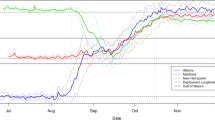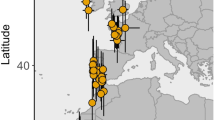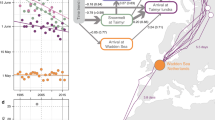Abstract
Only few bird species from Western Europe migrate eastward to wintering areas in South Asia, and little is known about this migratory flyway. The Common Rosefinch has in the past century expanded its breeding range westward to include Western Europe and migrate along this flyway to wintering sites in South Asia. This is the first study describing the migration routes of Common Rosefinches between Europe and Asia in detail, revealed by light level geolocators. The rosefinches showed loop-migration with more northerly routes in autumn than in spring, possibly in order to shorten the flight over the Central Asian deserts, which are very inhospitable at this time of the year. In spring the deserts are less dry and richer in vegetation, which may have supported the more southerly routes. During autumn migration the birds used several staging sites in Central Asia for prolonged periods. Although the birds passed over mountain regions at this time, which potentially act as barriers to them, the length of the stops seem unrealistically long for only fuel deposition. Instead, this suggests that the birds temporarily suspended migration to take advantage of abundant and predictable food sources in this region. During spring migration the birds made a few longer stops while still in north India or Central Asia, before migrating at fast speeds towards the breeding grounds. The birds covered 4–5000 km with only very short stopovers and thus most of the fuel used on spring migration must have been accumulated in Asia. Our results thus indicate that Central Asia, and north India, are important staging areas for this species in both autumn and spring. During winter, birds used two sites located several hundred kilometres apart, and relocation was probably a response to local food availability.
Zusammenfassung
Zugrouten und zeitlicher Ablauf des Zuges beim in Südasien überwinternden Karmingimpel ( Carpodacus erythrinus )
Nur wenige Vogelarten Westeuropas ziehen ostwärts zu Winterquartieren in Südasien, und über diesen Zugweg ist nur wenig bekannt. Der Karmingimpel hat im Lauf des vergangenen Jahrhunderts seine Brutgebiete westwärts über Westeuropa ausgedehnt und zieht entlang dieser Route zu Überwinterungsgebieten in Südasien. Dies ist die erste Studie, welche die Zugwege der Karmingimpel zwischen Europa und Asien mittels Daten von Hell-Dunkel-Geolokatoren detailliert beschreibt. Die Karmingimpel zeigten einen Schleifenzug, bei dem sie im Herbst weiter nördlich verlaufende Routen nutzten als im Frühjahr, möglicherweise um den Flug über die zentralasiatischen Wüsten zu verkürzen, die zu dieser Jahreszeit äußerst unwirtlich sind. Im Frühling sind die Wüsten weniger trocken und vegetationsreicher, was die südlicheren Routen begünstigt haben könnte. Auf dem Herbstzug nutzten die Vögel über ausgedehnte Zeiträume hinweg mehrere Rast- und Sammelplätze in Zentralasien. Obgleich die Vögel zu dieser Zeit über Gebirgsregionen zogen, die potenzielle Hindernisse für sie darstellen, erscheint die Dauer der Rastaufenthalte unrealistisch lang, um nur dem Auffüllen der Energiereserven zu dienen. Stattdessen deutet dies darauf hin, dass die Vögel den Zug vorübergehend unterbrachen, um die reichlichen und verlässlichen Nahrungsquellen dieser Region zu nutzen. Auf dem Frühjahrszug machten die Vögel noch in Nordindien oder Zentralasien ein paar längere Rastpausen, bevor sie in raschem Tempo weiter in die Brutgebiete flogen. Die Vögel legten mit sehr kurzen Unterbrechungen 4–5000 km zurück; somit muss der Großteil der auf dem Frühjahrszug verbrauchten Energiereserven in Asien angelegt worden sein. Unsere Ergebnisse deuten daher an, dass Zentralasien und Nordindien für diese Art sowohl im Herbst als auch im Frühjahr bedeutende Rast- und Sammelregionen sind. Während des Winters nutzten die Vögel zwei mehrere 100 km voneinander entfernte Gebiete, und Ortswechsel waren vermutlich Reaktionen auf lokale Nahrungsverfügbarkeit.

Similar content being viewed by others
References
Åkesson S, Klaassen R, Holmgren J, Fox JW, Hedenström A (2012) Migration routes and strategies in a highly aerial migrant, the Common Swift Apus apus, revealed by light-level geolocators. PLoS One 7:e41195
Ali S, Ripley SD (1974) Handbook of the birds of India and Pakistan, vol X. Oxford University Press, London, pp 166–167
Arlt D, Olsson P, Fox JW, Low M, Pärt T (2015) Prolonged stopover duration characterises migration strategy and constraints of a long-distance migrant songbird. Anim Migr 2:47–62
Bairlein F, Norris DR, Nagel R, Bulte M, Voigt CC, Fox JW, Hussell DJT, Schmaljohann H (2012) Cross-hemisphere migration of a 25 g songbird. Biol Lett 8:505–507
Bakken V, Runde O, Tjørve E (2006) Norwegian bird ringing atlas, vol II. Stavanger, p 446
Björklund M (1990) Mate choice is not important for female reproductive success in the Common Rosefinch (Carpodacus erythrinus). Auk 107:35–44
Björklund M (1992) Selection of bill size proportions in the Common Rosefinch (Carpodacus erythrinus). Auk 109:637–642
Bolshakov CV (2003) Nocturnal migration of passerines in the desert-highland zone of western Central Asia: selected aspects. In: Berthold P, Gwinner E, Sonnenschein E (eds) Avian migration. Springer, Berlin, pp 225–236
Bønløkke J, Madsen JJ, Thorup K, Pedersen KT, Bjerrum M, Rahbek C (2006) The Danish Bird Migration Atlas. Rhodos, Humlebæk, pp 798–799
Bozhko SI (1980) Der Karmingimpel. Neue Brehm-Bücherei 529, A. Ziemsen Verlag, Wittenberg, Lutherstadt
Bulyuk VN, Chernetsov N (2005) Nocturnal passage of passerines in Western Kazakhstan in autumn. J Arid Environ 61:603–607
Calenge C (2006) The package ‘adehabitat’ for R software: a tool for the analysis of space and habitat use by animals. Ecol Model 197:516–519
Chernetsov N, Bulyuk VN, Ktitorov P (2007) Migratory stopovers of passerines in an oasis at the crossroads of the African and Indian flyways. Ring Migr 23:243–251
Chernetsov N, Kishkinev D, Gashkov S, Kosarev V, Bolshakov CV (2008) Migratory programme of juvenile Pied Flycatchers, Ficedula hypoleuca, from Siberia implies a detour around Central Asia. Anim Behav 75:539–545
Cramp S, Perrins CM (eds) (1994) The birds of the Western Palearctic, vol VIII. Oxford University Press, Oxford
Dolnik VR (1990) Bird migration across arid and mountainous regions of Middle Asia and Kasakhstan. In: Gwinner E (ed) Bird migration: physiology and ecophysiology. Springer, Berlin, pp 368–386
Fransson T, Hall-Karlsson S (2008) Swedish bird ringing atlas, vol 3. Swedish Museum of Natural History, Stockholm, p 243
Fransson T, Jakobsson S, Kullberg C (2005) Non-random distribution of ring recoveries from trans-Saharan migrants indicates species-specific stopover areas. J Avian Biol 36:6–11
Fransson T, Barboutis C, Mellroth R, Akriotis T (2008) When and where to fuel before crossing the Sahara desert—extended stopover and migratory fuelling in first-year Garden Warblers Sylvia borin. J Avian Biol 39:133–138
Green M, Lindström Å (2014) Monitoring population changes of birds in Sweden. Annual report for 2013. Department of Biology, Lund University, p 78
Gunnarsson TG, Gill JA, Atkinson PW, Gélinaud G, Potts PM, Croger RE, Gudmundsson GA, Appleton GF, Sutherland WJ (2006) Population-scale drivers of individual arrival times in migratory birds. J Anim Ecol 75:1119–1127
Heckscher CM, Taylor SM, Fox JW, Afanasyev V (2011) Veery (Catharus fuscescens) winter locations, migratory connectivity, and a revision of its winter range using geolocator technology. Auk 128:531–542
Hill RD, Braun M (2001) Geolocation by light level—the next step: latitude. In: Sibert J, Nielsen J (eds) Electronic tagging and tracking in marine fisheries. Kluwer, Boston, pp 315–330
Jahn AE, Cueto VR, Fox JW, Husak MS, Kim DH, Landoll DV, Ledezma JP, Lepage HK, Levey DJ, Murphy MT, Renfrew RB (2013) Migration timing and wintering areas of three species of flycatchers (Tyrannus) breeding in the great plains of North America. Auk 130:247–257
Jones PJ (1995) Migration strategies of Palearctic passerines in Africa. Isr J Zool 41:393–406
Kirby JS, Stattersfield AJ, Butchart SHM, Evans MI, Grimmett RFA, Jones VR, O’Sullivan J, Tucker GM, Newton I (2008) Key conservation issues for migratory land- and waterbird species on the world’s major flyways. Bird Conserv Int 18:S49–S73
Lemke HW, Tarka M, Klaassen RHG, Åkesson M, Bensch S, Hasselquist D, Hansson B (2013) Annual cycle and migration strategies of a trans-Saharan migratory songbird: a geolocator study in the Great Reed Warbler. PLoS One 8:e79209
Lislevand T, Chutný B, Byrkjedal I, Pavel V, Briedis M, Adamik P, Hahn S (2015) Red-spotted Bluethroats Luscinia s. svecica migrate along the Indo-European flyway: a geolocator study. Bird Study 62:508–515
Lisovski S, Hahn S (2012) GeoLight—processing and analysing light-based geolocator data in R. Methods Ecol Evol 3:1055–1059
Lisovski S, Hewson CM, Klaassen RHG, Korner-Nievergelt F, Kristensen MW, Hahn S (2012) Geolocation by light: accuracy and precision affected by environmental factors. Methods Ecol Evol 3:603–612
McKinnon EA, Stanley CQ, Fraser KC, MacPherson MM, Casbourn G, Marra PP, Studds CE, Diggs N, Stutchbury BJM (2013) Estimating geolocator accuracy for a migratory songbird using live ground-truthing in tropical forest. Anim Migr 1:31–38
Morbey YE, Ydenberg RC (2001) Protandrous arrival timing to breeding areas: a review. Ecol Lett 4:663–673
Moreau RE (1952) The place of Africa in the Palaearctic migration system. J Anim Ecol 21:250–271
Moreau RE (1972) The Palearctic-African bird migration system. Academic Press, London
Newton I (2008) The migration ecology of birds. Academic Press, London
Nilsson C, Klaassen RHG, Alerstam T (2013) Difference in speed and duration of bird migration between spring and autumn. Am Nat 181:837–845
Paevskii VA (1973) Atlas of bird migrations according to banding data at the Courtland Spit. In: Bykhovskii BE (ed) Bird migrations: ecological and physiological factors. Wiley, Chichester, pp 1–124
Piha M (2014) Common Rosefinch—Carpodacus erythrinus. In: Valkama J, Lehikoinen A, Lehikoinen E, Piha M, Saurola P, Sola P, Velmala W (eds) The Finnish bird ringing atlas, vol II. Finnish Museum of Natural History, Helsinki, pp 717–720 (in Finnish with English summary)
Rappole JH, Tipton AR (1991) New harness design for attachment of radio transmitters to small passerines. J Field Ornithol 62:335–337
Salewski V, Flade M, Poluda A, Kiljan G, Liechti F, Lisovski S, Hahn S (2013) An unknown migration route of the ‘globally threatened’ Aquatic Warbler revealed by geolocators. J Ornithol 154:549–552
Smith RJ, Moore FR (2005) Arrival timing and seasonal reproductive performance in a long-distance migratory landbird. Behav Ecol Sociobiol 57:231–239
Stach R, Jakobsson S, Kullberg C, Fransson T (2012) Geolocators reveal three consecutive wintering areas in the Thrush Nightingale. Anim Migr 1:1–7
Stjenberg T (1979) Breeding biology and population dynamics of the Scarlet Rosefinch Carpodacus erythrinus. Acta Zoologica Fennica 157, Dissertation, University of Helsinki
Stjernberg T (1985) Recent expansion of the Scarlet Resefinch (Carpodacus erythrinus) in Europe. In: Proceedings of the XVIII international ornithological congress, Moscow, pp 743–753
Stjernberg T (2014) High site-tenacity in breeding Common Rosefinches. In: Valkama J, Lehikoinen A, Lehikoinen E, Piha M, Saurola P, Sola P, Velmala W (eds) The Finnish bird ringing atlas, vol II. Finnish Museum of Natural History, Helsinki, pp 721–723 (in Finnish with English summary)
Stutchbury BJM, Tarof SA, Done T, Gow E, Kramer PM, Tautin J, Fox JW, Afanasyev V (2009) Tracking long-distance songbird migration by using geolocators. Science 323:896
Acknowledgments
We thank Tuomo Kolehmainen for valuable assistance during fieldwork. We are grateful to Dr. Victor N. Bulyuk and one anonymous reviewer for improving the original manuscript. We would also like to extend our gratitude to Dr. Victor N. Bulyuk for generously sharing data on Rosefinches from studies published in Russian. Birds were captured and ringed with permission from the Swedish Bird Ringing Centre, Swedish Museum of Natural History. The procedure of this study was reviewed and approved by the regional Swedish Ethical Committee (permit Stockholm Södra Djurförsöksetiska nämnd Dnr S 41-11).
Author information
Authors and Affiliations
Corresponding author
Additional information
Communicated by N. Chernetsov.
Electronic supplementary material
Below is the link to the electronic supplementary material.
Rights and permissions
About this article
Cite this article
Stach, R., Kullberg, C., Jakobsson, S. et al. Migration routes and timing in a bird wintering in South Asia, the Common Rosefinch Carpodacus erythrinus . J Ornithol 157, 671–679 (2016). https://doi.org/10.1007/s10336-016-1329-3
Received:
Revised:
Accepted:
Published:
Issue Date:
DOI: https://doi.org/10.1007/s10336-016-1329-3




